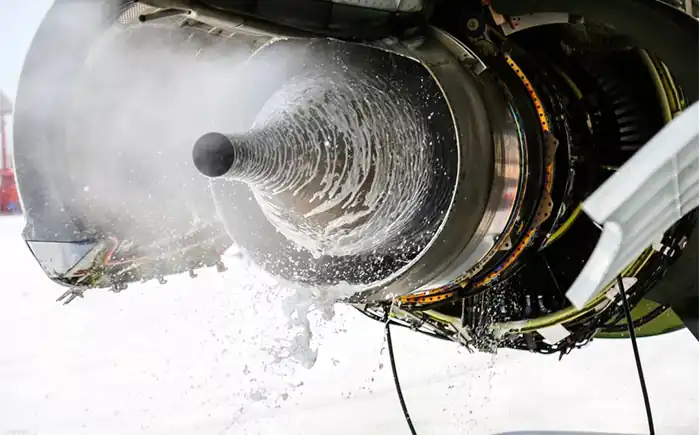In the aviation industry, the cleaning and maintenance of aircraft is crucial to safety, durability and performance. Traditional aviation cleaning materials often face challenges such as strong corrosiveness, poor environmental protection or insufficient cleaning efficiency. Magnesium oxide (MgO) is becoming a key component of the new generation of aviation cleaning materials, especially in the fields of engine components, fuselage surfaces and precision instrument cleaning.

1. The characteristics of magnesium oxide are highly consistent with the requirements of aviation cleaning
Weak alkaline corrosion protection: The aqueous magnesium oxide solution is weakly alkaline (pH about 10.3), which can effectively neutralize acidic pollutants attached to the surface of the aircraft (such as sulfides and nitrogen oxides left in fuel combustion), while avoiding the corrosion risk of strong alkaline cleaning agents on aviation materials such as aluminum alloys and titanium alloys, and protecting the structural integrity of the fuselage and engine components.
High adsorptionability and decomposition ability: Nano-scale magnesium oxide has a very large specific surface area and microporous structure, and can adsorb oils, carbon deposits and particulate pollutants. Its surfactant sites can also catalyze the decomposition of organic matter (such as oil stains and colloids), which can achieve efficient cleaning under low temperature conditions and reduce dependence on high-temperature and high-pressure cleaning equipment.
High temperature resistance: The decomposition temperature of magnesium oxide is as high as 2800°C. In the cleaning of high-temperature components of aircraft engines (such as turbine blades), it can withstand local high-temperature environments and avoid failure or residues of the cleaning material itself.
Environmental safety: Magnesium oxide is non-toxic, volatile organic compounds (VOC), cleaning waste liquid is easy to deal with, and meets the strict requirements of the international aviation industry for environmentally friendly cleaning agents (such as ISO14001 standard) and occupational health and safety (OHSAS18001).
2. Typical application scenarios of magnesium oxide in aviation cleaning
Carbon deposit cleaning of engines: Inadequate combustion of fuel will form stubborn carbon deposits, affecting heat dissipation efficiency and aerodynamic performance. The aqueous cleaning slurry with magnesium oxide as the core component can penetrate into the inside of complex structures such as turbine blades and combustion chambers through spraying or soaking, softening and peeling off carbon deposits, and at the same time repairing the oxide layer on the metal surface. After an airline uses a cleaning agent containing nano magnesium oxide, the engine overhaul cycle is extended by 20%, and the fuel efficiency is increased by 3%-5%.
Floor surface maintenance: The aircraft fuselage is exposed to the atmosphere for a long time and is prone to salt spray, microorganisms (molds) and pollutants. Magnesium oxide-based environmentally friendly cleaning agents can replace traditional organic solvents, quickly remove stains without leaving any water marks. They can also form protective films on the surface and delay corrosion.
Precision instruments and electronic equipment cleaning: The insulating and non-grinding properties of magnesium oxide make it suitable for cleaning of precision components such as avionics and sensors. Its nanoparticles can penetrate deep into tiny gaps to absorb dust, avoiding damage caused by mechanical wiping.
Composite component maintenance: For carbon fiber reinforced composite (CFRP) wings, hatch doors and other components, magnesium oxide-based cleaning agents can effectively remove mold release agent residues and contaminants without causing resin matrix swelling or interface peeling.
3. Technology breakthrough and innovation direction
Functional modification improves performance
Surface coating technology: Modify silanes or polymers on the surface of magnesium oxide particles to enhance their affinity with organic pollutants.
Ion doping: introduces calcium and zinc plasma to improve the chelation ability of magnesium oxide to heavy metal pollutants.
Compound formula development
Combine magnesium oxide with biological enzymes, corrosion inhibitors, and surfactants to form a “coordinated cleaning system”. For example:
Magnesium oxide + lipase: targeted decomposition of stubborn oils;
Magnesium oxide + rare earth compounds: realize the integration of metal surface passivation and gloss repair.
Green craft upgrade
Develop recyclable magnesium oxide-based cleaning materials, and realize recycling through centrifugal separation or magnetic separation technology to reduce the operation and maintenance costs of airlines.
4. Industry prospects and challenges
According to the Global Aviation Cleaning Materials Market Report, the annual compound growth rate of environmentally friendly aviation cleaning agents will reach 8.2% from 2025 to 2030, and magnesium oxide is expected to occupy more than 25% of the market share with its comprehensive performance. The challenges currently face mainly include:
Technical barriers: The dispersion stability of nanomagnesium oxide needs to be further optimized;
The standard is missing: the industry certification system for aviation-grade magnesium oxide cleaning agents is not yet perfect;
Cost control: The demand for large-scale production of high-purity nanomaterials is urgent.
5. Conclusion
The application of magnesium oxide in aviation cleaning materials reflects the industrial innovation logic of “improving quality with materials”. With the increase in the aviation industry’s demand for efficient and environmental protection, magnesium oxide-based cleaning agents will become one of the key technologies to ensure flight safety and reduce carbon emissions. In the future, through breakthroughs in technical bottlenecks through industry-university-research cooperation, magnesium oxide may be upgraded from “auxiliary materials” to a core solution for aviation green operation and maintenance.
Messi Biology has been in this field for many years. The aviation-grade high-purity magnesium oxide it has developed has passed supplier certification and has carried out pilot cooperation with many international airlines to help the global aviation industry innovate in clean technology.
